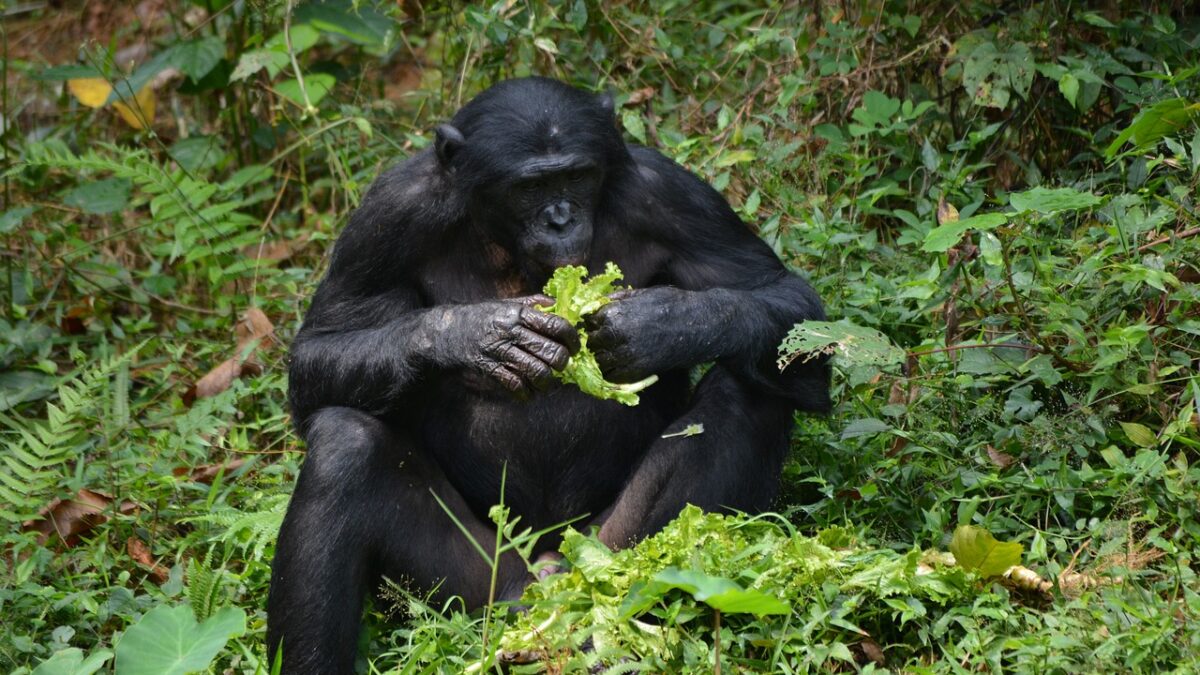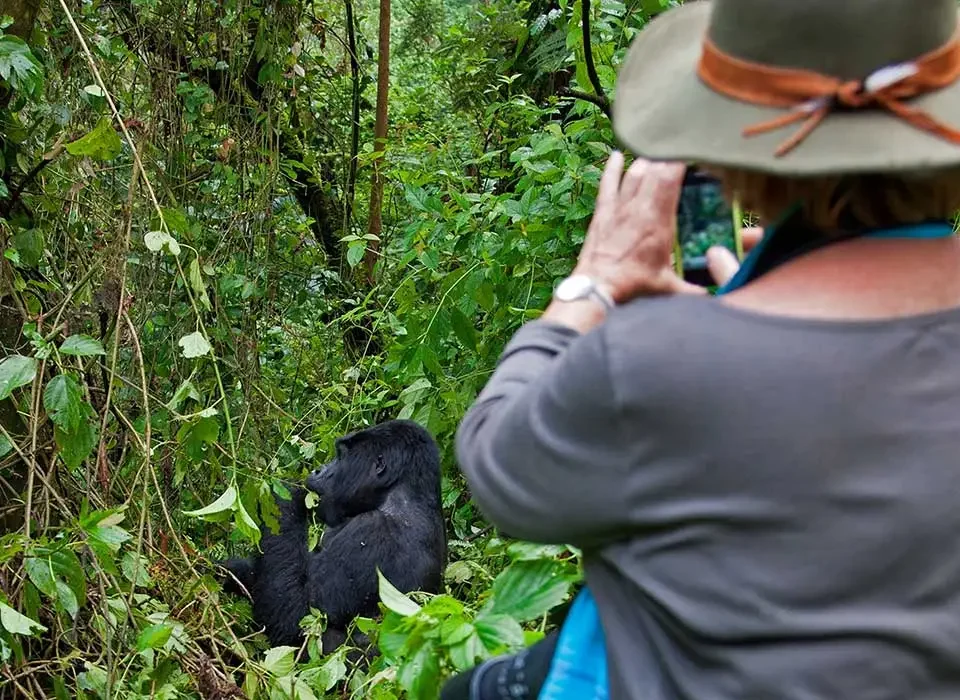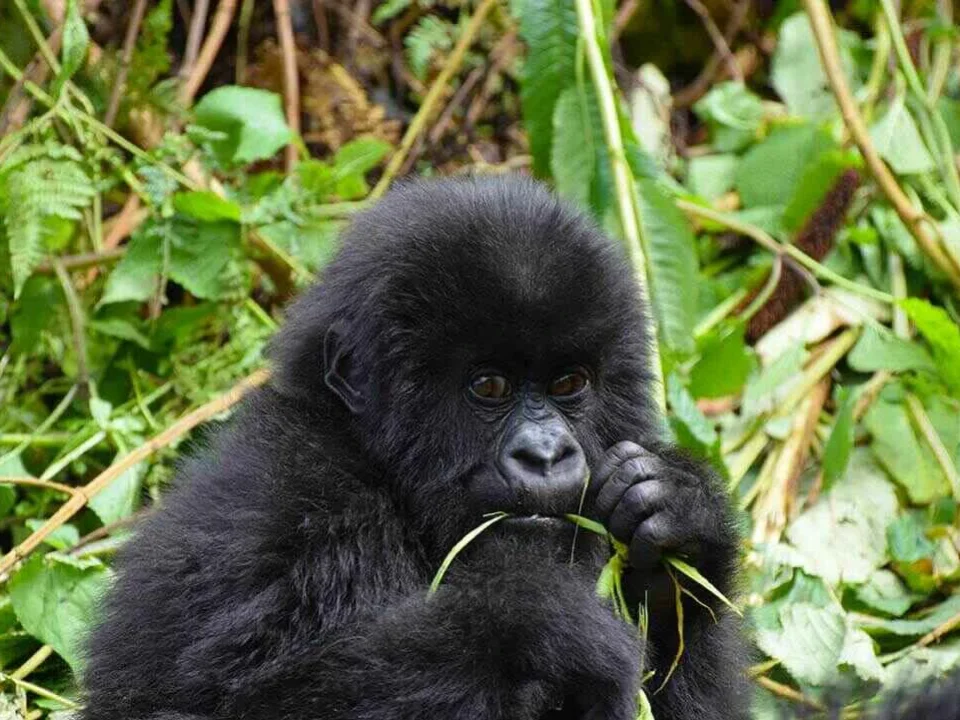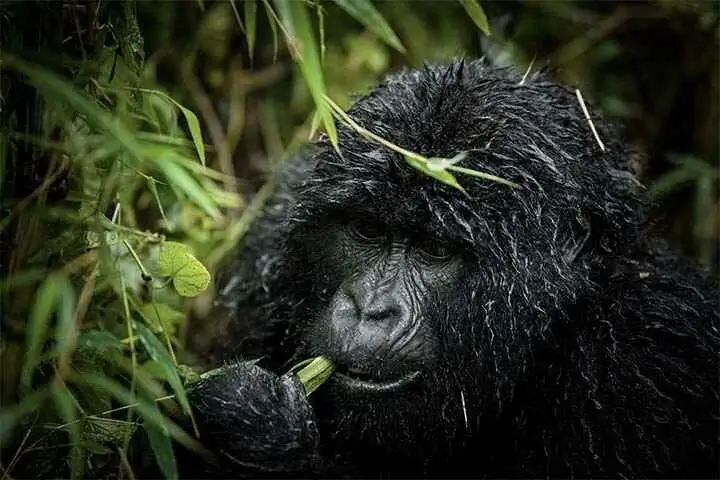
Discovering the Unique Wildlife of the Congo Basin
November 7, 2024
What Time Does One Spend with the Gorillas in the DRC?
November 9, 2024The Democratic Republic of Congo (DRC) is one of the few places on earth where you can have extraordinary encounters with two of the world’s most fascinating primates: mountain gorillas and bonobos. These species, though sharing a common ancestor, offer distinctly different experiences for travelers. If you’re planning a primate adventure in the DRC, understanding the contrasts between mountain gorilla trekking and visiting bonobos can help you decide which one or both is the right fit for your safari.
Understanding the Species
Mountain gorillas are a subspecies of the eastern gorilla, found in the misty highlands of the Virunga Mountains. They are known for their powerful build, shy nature, and strong social bonds within family groups. The experience of standing just a few meters away from a massive silverback is both thrilling and humbling, as you witness their gentle interactions with their families. Mountain gorillas are critically endangered, with only around 1,100 left in the wild, making each sighting a rare privilege.
Bonobos, on the other hand, are a species of great ape found only in the dense rainforests of the Congo Basin. They are our closest living relatives, sharing over 98% of our DNA, and are known for their peaceful and matriarchal societies. Unlike their more aggressive cousins, the chimpanzees, bonobos exhibit cooperative and playful behaviors, often using grooming and social bonding to resolve conflicts. Observing bonobos offers an intriguing glimpse into a side of primate behavior that is gentle, harmonious, and remarkably human-like.
Locations and Accessibility
In the DRC, mountain gorilla trekking takes place in Virunga National Park, the oldest national park in Africa. The park is accessible from the city of Goma, which serves as the main gateway for travelers. Virunga’s rugged terrain and towering volcanoes make for an adventurous journey, as you hike through thick forest and steep slopes in search of gorilla families.
For those interested in bonobos, the most accessible option is visiting the Lola ya Bonobo Sanctuary near Kinshasa, where orphaned bonobos are rehabilitated before being reintroduced into the wild. For a more immersive experience, you can venture deeper into the Congo Basin to Salonga National Park, home to wild bonobos. Reaching Salonga requires a combination of flights and boat trips, offering a true off-the-beaten-path adventure.
Choosing between the two experiences often comes down to accessibility and the level of physical challenge you prefer. Gorilla trekking in Virunga involves strenuous hiking at high altitudes, while visiting bonobos, especially at a sanctuary, tends to be less physically demanding.
The Trekking Experience
Mountain gorilla trekking is an unforgettable adventure that typically begins early in the morning. After a briefing by park rangers, you set off on foot into the forest, led by expert guides who track the gorillas’ movements. The trek can take anywhere from 30 minutes to several hours, depending on where the gorillas are located. Once you find them, you are allowed to spend up to one hour observing the group, watching as they feed, groom each other, and play. It’s a mesmerizing experience, filled with moments of awe as you witness the bond between a silverback and his family.
In contrast, visiting bonobos is often more about observing their unique social behaviors. At the Lola ya Bonobo Sanctuary, you can walk along designated trails, getting close views of these intelligent apes as they interact with each other. Watching bonobos is a chance to see the softer side of primate behavior — the grooming, playing, and social bonding that define their peaceful societies. For those who choose to visit wild bonobos in Salonga National Park, the experience involves trekking through dense rainforest, where the focus is on spotting these elusive primates in their natural habitat.
Social Structures and Behaviors
Mountain gorillas live in tight-knit family groups led by a dominant silverback male. The silverback’s role as the leader, protector, and decision-maker is central to the group’s dynamics. Observing a gorilla family reveals the strong bonds that tie them together, from the playful antics of juveniles to the nurturing behavior of mother gorillas. It’s a powerful reminder of the complex social structures that exist among these gentle giants.
Bonobos, in contrast, have a matriarchal society where females often hold the highest status. They are known for their cooperative and peaceful nature, using grooming and sexual behavior as ways to maintain social harmony. Watching bonobos provides a fascinating insight into a primate society that is largely egalitarian and conflict-averse, offering a different perspective on the evolution of social behavior among great apes.
Conservation Efforts and Ethical Tourism
Both mountain gorillas and bonobos are critically endangered, facing threats from habitat destruction, poaching, and disease. Conservation efforts in the DRC are crucial for the survival of these species, and tourism plays a vital role in funding these initiatives.
Virunga National Park has been at the forefront of mountain gorilla conservation, with dedicated rangers protecting the park from illegal activities. The revenue generated from gorilla trekking permits supports anti-poaching efforts and community development projects, helping to preserve the gorillas’ natural habitat.
For bonobos, sanctuaries like Lola ya Bonobo focus on rescuing orphaned bonobos and rehabilitating them for reintroduction into the wild. These sanctuaries not only provide a safe haven for bonobos but also serve as educational centers that raise awareness about the threats these primates face. Visiting these sites contributes directly to conservation efforts, helping to protect bonobos from the bushmeat trade and habitat loss.
Costs and Booking Information
Gorilla trekking in the DRC is more affordable compared to neighboring Rwanda and Uganda. A permit for gorilla trekking in Virunga National Park costs around $400 per person, making it a budget-friendly option for travelers seeking a premium experience. This fee includes the services of experienced guides and trackers, as well as contributions to conservation projects.
Visiting the Lola ya Bonobo Sanctuary costs about $40 per person, providing an accessible and affordable way to see bonobos up close. For those embarking on a more extensive journey to Salonga National Park, the costs can be higher due to the remote nature of the destination and the logistical arrangements required.
Booking your permits in advance is essential, particularly for gorilla trekking, as permits are limited to ensure a minimal impact on the gorilla families. At Exclusive Gorilla Journeys, we handle all the necessary arrangements, from securing permits to organizing guided tours, ensuring a smooth and hassle-free experience.
Which Experience Should You Choose?
Your choice between mountain gorilla trekking and visiting bonobos depends largely on your interests and physical capabilities. If you’re drawn to the idea of trekking through misty mountains and coming face-to-face with a powerful silverback, mountain gorilla trekking offers a thrilling adventure. It’s perfect for those seeking a physically challenging experience and the chance to observe the powerful family dynamics of these gentle giants.
On the other hand, if you are more interested in observing unique social behaviors and prefer a less strenuous experience, visiting bonobos is an excellent option. Bonobos offer a glimpse into a peaceful and cooperative primate society, making it a fascinating experience for those curious about our closest genetic relatives.
For the ultimate primate adventure, consider combining both experiences in one trip. This allows you to explore the diverse landscapes of the DRC, from the volcanic mountains of Virunga to the rainforests of the Congo Basin, giving you a comprehensive understanding of the country’s incredible primate diversity.
Plan Your Primate Safari with Exclusive Gorilla Journeys
At Exclusive Gorilla Journeys, we specialize in tailored safari experiences that bring you closer to Africa’s most iconic wildlife. Whether you choose to trek with mountain gorillas, observe the unique behavior of bonobos, or combine both experiences, our expert guides ensure a memorable and impactful journey. Contact us today to start planning your DRC primate adventure and discover the magic of these incredible great apes.




